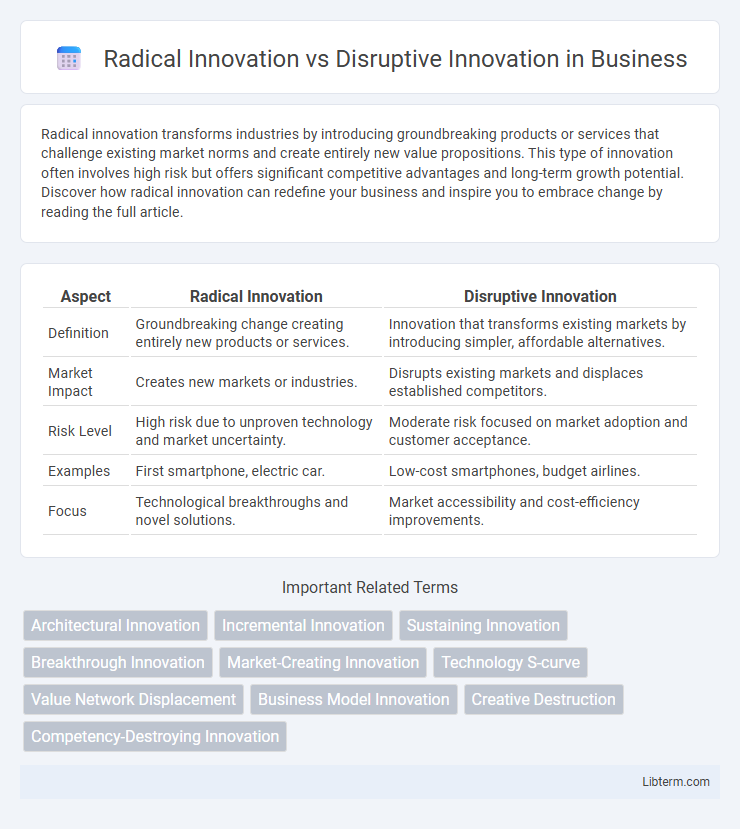Radical innovation transforms industries by introducing groundbreaking products or services that challenge existing market norms and create entirely new value propositions. This type of innovation often involves high risk but offers significant competitive advantages and long-term growth potential. Discover how radical innovation can redefine your business and inspire you to embrace change by reading the full article.
Table of Comparison
| Aspect | Radical Innovation | Disruptive Innovation |
|---|---|---|
| Definition | Groundbreaking change creating entirely new products or services. | Innovation that transforms existing markets by introducing simpler, affordable alternatives. |
| Market Impact | Creates new markets or industries. | Disrupts existing markets and displaces established competitors. |
| Risk Level | High risk due to unproven technology and market uncertainty. | Moderate risk focused on market adoption and customer acceptance. |
| Examples | First smartphone, electric car. | Low-cost smartphones, budget airlines. |
| Focus | Technological breakthroughs and novel solutions. | Market accessibility and cost-efficiency improvements. |
Introduction to Radical and Disruptive Innovation
Radical innovation introduces groundbreaking technologies or processes that significantly transform existing industries by creating novel markets or redefining value chains. Disruptive innovation, often emerging from underperforming markets, alters competitive dynamics by offering simpler, more affordable solutions that eventually displace established products or services. Understanding the distinction between radical and disruptive innovation is crucial for organizations aiming to strategically navigate market evolution and drive sustainable growth.
Defining Radical Innovation
Radical Innovation refers to groundbreaking advancements that create entirely new markets or transform existing ones by introducing novel technologies or business models with significant improvements in performance or value. It often involves high uncertainty and substantial investment but can lead to substantial competitive advantage and long-term growth. Unlike incremental innovation, radical innovation reshapes industries by challenging established norms and driving substantial change.
Defining Disruptive Innovation
Disruptive innovation refers to a process where a smaller company with fewer resources successfully challenges established incumbent businesses by targeting overlooked segments and delivering more accessible, affordable, or convenient products or services. This type of innovation typically starts with inferior performance compared to existing solutions but improves rapidly to eventually displace established competitors. Unlike radical innovation, which involves breakthrough technologies or entirely new markets, disruptive innovation reshapes market dynamics by transforming products and customer expectations within existing industries.
Core Differences Between Radical and Disruptive Innovation
Radical innovation introduces groundbreaking changes that transform existing products or services through significant technological advances, targeting current markets with enhanced value. Disruptive innovation, however, initially targets overlooked or underserved market segments with simpler, more affordable solutions, eventually displacing established competitors. The core difference lies in radical innovation's focus on breakthrough improvements versus disruptive innovation's emphasis on market entry strategy and gradual market dominance.
Market Impact: Radical vs Disruptive Innovation
Radical innovation introduces groundbreaking technologies or products that fundamentally change existing markets or create entirely new ones, often requiring significant shifts in consumer behavior and industry standards. Disruptive innovation begins with simpler, more affordable solutions targeting underserved or niche market segments, gradually improving until they overtake established competitors and transform mainstream markets. The market impact of radical innovation tends to be immediate and profound, while disruptive innovation creates long-term market shifts by altering competitive dynamics incrementally.
Key Examples of Radical Innovation
Radical innovation involves groundbreaking advancements that create entirely new markets or revolutionize existing industries, exemplified by the invention of the personal computer by Apple and the development of the internet by DARPA. These innovations differ from disruptive innovation, which typically improve or redefine existing products and services for a broader market, like Netflix's streaming service disrupting traditional video rental. Key examples of radical innovation showcase technologies that fundamentally alter technological paradigms and consumer behavior on a global scale.
Key Examples of Disruptive Innovation
Disruptive innovation transforms markets by introducing affordable, accessible products that initially target niche or underserved segments, eventually overtaking established competitors. Notable examples include Netflix, which revolutionized entertainment distribution by shifting from DVD rentals to streaming services, and Airbnb, which disrupted the traditional hotel industry by enabling peer-to-peer lodging. These innovations leverage technology to create new value networks, reshaping customer expectations and industry standards.
Challenges and Opportunities in Each Innovation Type
Radical innovation involves creating entirely new products or technologies, presenting challenges such as high R&D costs, uncertain market acceptance, and integration complexities within existing systems. Disruptive innovation targets existing markets with simpler, more affordable solutions, facing challenges related to market resistance from established players and the need to scale quickly to capture market share. Opportunities in radical innovation include establishing market leadership and long-term competitive advantage, while disruptive innovation offers rapid growth potential by transforming customer behaviors and opening underserved market segments.
Choosing the Right Innovation Strategy
Radical innovation introduces breakthrough technologies or products that create new markets, while disruptive innovation targets existing markets by offering simpler, more affordable alternatives that eventually displace established competitors. Choosing the right innovation strategy depends on a company's resources, market conditions, and long-term goals; radical innovation suits businesses seeking transformative growth, whereas disruptive innovation benefits firms aiming to capture underserved segments. Aligning innovation strategy with organizational capabilities and customer needs maximizes competitive advantage and sustainable success.
The Future of Radical and Disruptive Innovation
Radical innovation reshapes industries by introducing groundbreaking technologies, while disruptive innovation transforms markets by redefining value propositions and customer bases. The future of both types hinges on advances in artificial intelligence, biotechnology, and renewable energy, sectors poised to drive profound economic and societal shifts. Companies investing in continuous R&D and agile strategies will capitalize on emerging opportunities, fostering sustainable growth through these innovation paradigms.
Radical Innovation Infographic

 libterm.com
libterm.com